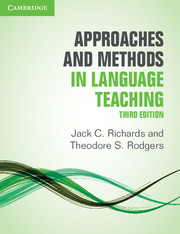Book contents
- Frontmatter
- Contents
- Acknowledgments
- Introduction to the third edition
- I Major trends in twentieth-century language teaching
- II Current approaches and methods
- III Alternative twentieth-century approaches and methods
- IV The teaching and learning environment
- Appendix: Comparison of approaches and methods
- Author index
- Subject index
10 - Text-Based Instruction
Published online by Cambridge University Press: 08 April 2022
- Frontmatter
- Contents
- Acknowledgments
- Introduction to the third edition
- I Major trends in twentieth-century language teaching
- II Current approaches and methods
- III Alternative twentieth-century approaches and methods
- IV The teaching and learning environment
- Appendix: Comparison of approaches and methods
- Author index
- Subject index
Summary
Introduction
Text-Based Instruction (TBI) is an approach that is based on the following principles:
• Teaching explicitly about the structures and grammatical features of spoken and written texts
• Linking spoken and written texts to the social and cultural contexts of their use
• Designing units of work which focus on developing skills in relation to whole texts
• Providing students with guided practice as they develop language skills for mean-ingful communication through whole texts.
(Feez 1998: v)
While developed originally in Australia through the work of educationalists and applied linguists working in the area of literacy and drawing on the work of Halliday (1989), Derewianka (1990), Christie (2002), and others, it has also been influential in developing approaches to language teaching at all levels in countries such as New Zealand, Singapore, and Canada, as well as in a number of European countries, such as Sweden. The Common European Framework of Reference (Chapter 8) also specifies outcomes for what students can do with texts. TBI shares many assumptions with a genre-based approach to course design, often used in the development of courses in English for Academic Purposes (Paltridge 2006). Unlike Task-Based Language Teaching (Chapter 9), which is motivated by a creative-construction theory of second language learning, TBI, while compatible with theories of learning, derives from a genre theory of the nature of language (see below) and the role that texts play in social contexts. Communicative competence is seen to involve the mastery of different types of texts, or genres. Text here is used in a special sense to refer to structured sequences of language that are used in specific contexts in specific ways. For example, in the course of a day a speaker of English may use spoken English in many different ways including the following:
• Casual conversational exchange with a friend
• Conversational exchange with a stranger in an elevator
• Telephone call to arrange an appointment at a hair salonllAn account to friends of an unusual experience
• Discussion of a personal problem with a friend to seek advice.
Each of these uses of language can be regarded as a text in that it exists as a unified whole with a beginning, middle, and end, it conforms to norms of organization and content, and it draws on appropriate grammar and vocabulary.
- Type
- Chapter
- Information
- Approaches and Methods in Language Teaching , pp. 200 - 214Publisher: Cambridge University PressPrint publication year: 2014

